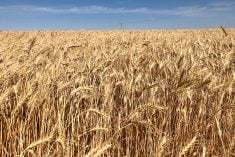CHICAGO, Jan 21 (Reuters) – One of the harshest winters in years in the U.S. Plains and Midwest, coupled with severe dryness in parts of the region, has left the dormant winter wheat crop at a higher than normal risk of damage.
Temperatures on Jan. 6 plummeted to minus 20 degrees Fahrenheit (minus 29 Celsius) in the Midwest, while readings in the southern Plains were in the single digits (F) as far south as Amarillo, Texas. Another Arctic blast is forecast to hit the Midwest late this week.
A protective blanket of snow insulated much of the wheat earlier this month, especially in the northern Midwest, agronomists said. But crops in exposed areas may have been damaged, and the extent will not be clear until spring.
Read Also

U.S. grains: Soybean futures inch higher on China trade optimism
U.S. soybean futures firmed on Wednesday as traders remained hopeful for progress in trade talks with top soy buyer China and on a Japanese proposal to increase U.S. soy purchases, deals that could help U.S. farmers avert major losses.
“We have a real problem area in west-central, southwest and portions of south-central Nebraska. There is some concern with winterkill,” said Al Dutcher, Nebraska’s state climatologist.
“As long as we don’t have this protective snow cover, we have got to be concerned with these Arctic intrusions,” Dutcher said.
Temperatures are expected to drop to minus 5 degrees F (minus 20.5 C) by Thursday as far south as central Illinois, an important region for soft red winter wheat, used to make cookies and snack foods.
“Some spotty winterkill will be possible across west central Illinois, far northern Missouri, southern Iowa, central and eastern Nebraska and far northeastern Kansas on Thursday morning,” MDA Weather Services forecaster Don Keeney said in a note to clients on Tuesday.
Snow cover will be critical. A fresh layer of snow across northern Illinois, Indiana and Ohio should protect wheat in those regions. But snow cover is absent from central Indiana westward to Missouri, and in the Plains states from Nebraska south to Texas.
At this time of year, winter wheat is most resistant to freeze injury and can endure temperatures down to around minus 5 to minus 10 F for several hours. Freeze damage is more common in the spring, when the crop resumes growing and loses its winter-hardiness, becoming more vulnerable to cold snaps.
DROUGHT LINGERS IN PLAINS
Dry soil is the main worry in the southern Plains, including Kansas, the top wheat-producing state, agronomists said. The latest weekly report from the U.S. Drought Monitor, produced by a consortium of climatologists, showed the western third of Kansas mired in a severe drought.
“Dryness still a major concern,” said Jim Shroyer, an agronomist with Kansas State University. “They had some snow in November and December out west… But six inches down, it’s dry, and some areas are dry as a bone,” he said.
Soil temperatures in Kansas fell low enough in early January to cause winterkill in part of Republic County, bordering Nebraska, but not in other areas of the state, Shroyer said.
In Oklahoma, another major producer of hard red winter wheat, 38 percent of the state was in moderate drought, with 5 percent, mostly in the far southwest, in extreme drought.
“We are in much better shape than in the past couple of years, but we could still use some moisture,” said Jeff Edwards, an agronomist with Oklahoma State University.
January and February are normally dry months in the region, but the current drought will make spring rains all the more critical for the wheat as it emerges from dormancy.
“We can get by on very little moisture until about mid-March, and that’s when it really starts hurting, and hurting rapidly,” Edwards said.
Drought is also a concern in the Pacific Northwest, which produces soft white wheat used in pastries and Asian noodles.
U.S. plantings of winter wheat, estimated by the U.S. Department of Agriculture at 41.9 million acres, are down about 3 percent from last year but close to the 10-year average.














